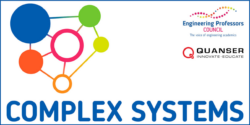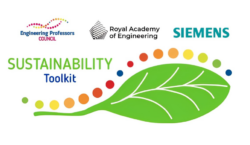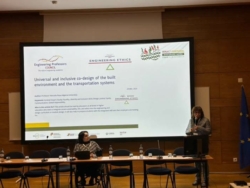Media release
Release date: 1st December 2025
New toolkit helps tomorrow’s engineers understand complex systems
A new, free resource, launched today by the Engineering Professors’ Council, will provide an open-access online toolkit to help engineering educators build complex systems concepts directly into their teaching and prepare future engineers for tomorrow’s challenges.
The Complex Systems Toolkit, created by the Engineering Professors’ Council (EPC) in partnership with Quanser, helps engineers to learn to tackle an increasing range of factors that interact in unpredictable ways. This fills a critical gap in traditional engineering education, where students tended to learn subjects in controlled and isolated conditions.
The new toolkit gives educators a set of resources to teach students to understand and design systems that are not only technically sound, but also resilient, trustworthy, and ethically robust. This involves learning to analyse, model and navigate complexity, to collaborate across disciplines, and to manage complex technical and sociotechnical systems.
It is not just students who benefit. Learning how to integrate complex systems in engineering also supports educators in their own professional development, since many may themselves never have been taught the necessary knowledge, skills, and mindsets that they are now expected to teach.
The Complex Systems Toolkit solves these challenges with a suite of guidance articles, teaching materials and case studies helping to build essential competencies for future engineers, in order to ensure a safer and more equitable world.
Integrating complex systems into engineering teaching aligns with professional standards and accreditation requirements, and also complements institutional goals around interdisciplinarity, sustainability and EDI, allowing the UK to position itself as a leader in engineering education that enables people and the planet to thrive.
The development of the Toolkit was guided by a Working Group comprised of experts from academia, industry and professional bodies. They have worked to produce a toolkit, rooted in educational best practice, that is aligned with the UK Engineering Council’s Accreditation of Higher Education Programmes (AHEP) criteria (the conditions for courses to receive professional accreditation) as well as addressing competencies outlined by the International Council on Systems Engineering (INCOSE).
The Toolkit features advice to educators who want to teach complex systems but are not sure where to begin, as well as ready-to-use classroom resources including case studies and activities that highlight current and emerging real-world issues and can be used and adapted by anyone.
Dr. Nikita Hari, Head of the Teaching and Research Design Support Group at the Department of Engineering Science, University of Oxford, and Working Group Co-Chair comments: “Engineering graduates of today are expected to design climate-resilient cities, ethically deploy AI, and weave circular-economy thinking into supply chains – and all this lives squarely in the messy realm of complex systems. Yet most engineering curricula still treat complexity as an afterthought or a niche elective. This is often misunderstood, misrepresented, or purely ignored, relegating complexity to a footnote.
“The Engineering Professors’ Council’s Complex Systems Toolkit is our academic response, aiming to bridge this gap: a freely accessible, peer-reviewed, resource hub where academics can find, curate and share ready-to-teach resources, assessment blueprints and real-world case studies mapped to AHEP learning outcomes.”
Paul Gilbert, CEO of Quanser, adds: “At Quanser, our mission has always been to help educators bring authentic, system-level engineering experiences to their students. Partnering with the EPC on the Complex Systems Toolkit is a unique opportunity to extend that mission in a way that truly scales. This Toolkit brings academic insight and practical, real-world systems thinking together in a way that empowers educators everywhere. I’m proud of what we’ve created together, and even more excited for how it will help shape the next generation of engineers to thrive in a world defined by complexity.”
An online launch of the Toolkit will take place on 9th December at a free webinar, during which attendees will be given a tour of its contents. To attend, register at https://epc.ac.uk/event/complex-systems-toolkit-launch-webinar/
The Complex Systems Toolkit is an open access and free to use suite of resources, available at http://epc.ac.uk/complex-systems-toolkit
A full press pack can be downloaded from: https://www.dropbox.com/scl/fo/cyqsu43psebige4s9ym0z/APr2oJC_8A0xGnumvCPkUX0?rlkey=e6zyq6b5ab8v6jh3423l6oj0h&st=div86irp&dl=0
Ends
Notes to editors
- Quanser is a world leader in the design and development of cutting-edge solutions that form an interdisciplinary ecosystem for engineering education and research.
- Please get in touch for further information, or enquiries about interviews, features or workshops.
Contact
Contact: Johnny Rich
Email: press@epc.ac.uk
Phone: 0781 111 4292
Website: https://epc.ac.uk/resources/toolkit/complex-systems-toolkit/
LinkedIn: https://www.linkedin.com/company/engineering-professors’%E2%80%8B-council
Tags: #ComplexSystems #ComplexSystemsToolkit
This post is also available here.
 You can now view the recording of the official launch webinar for the EPC’s new Complex Systems Toolkit, supported by Quanser. The webinar was live on Tuesday 9th December 2025, 3pm-4.30pm GMT.
You can now view the recording of the official launch webinar for the EPC’s new Complex Systems Toolkit, supported by Quanser. The webinar was live on Tuesday 9th December 2025, 3pm-4.30pm GMT. You can now view the recording of the official launch webinar for the EPC’s new
You can now view the recording of the official launch webinar for the EPC’s new 

